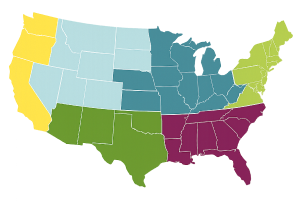
How do we use your location?
Knowing your location helps us recommend plants that will thrive in your climate, based on your Growing Zone.
If you want an authentically wild' look, but also a spectacular display, this is the one. The Poet's Daffodils are among the oldest members of the flower kingdom, a true heirloom species, very close to the true wild form. (Most true species daffodils, the real 'wildflowers' that have been hybridized for years, are very small plants, but this one is strong and tall with large flowers.)
Since it is so ancient, it is one of the most perennial daffodils of them all. Once you plant them, you'll have them forever. It's fitting that when Linnaeus, the famous early scientist who invented Latin botanical nomenclature, named this flower, he christened it Narcissus poeticus recurvus. He simply decided that this is the one that best represents the early poet's story of Narcissus, the famous handsome youth from Greek mythology. Remember Narcissus? He was the young man who was so handsome he fell in love with himself while gazing into a reflecting pool. Today we know that the whole family of daffodils ended up being called 'narcissus', but the 'poeticus' in the name of this one is the direct connection to the early myths, and an official historic tribute to the incredible beauty of this particular flower. Of course, the myth of Narcissus gives us modern psychology's 'Narcissus complex', and men who are very vain are still called 'narcissistic.'
In botanical history, however, a great story and a great name don't necessarily point to a great plant for today. But in this case, they certainly do, especially for gardeners who love really beautiful flowers that take absolutely no care.
There are only a handful of choices among 'Poet's Daffodils'; they are so unique they create their own category among Dutch daffodil types. One is called 'Old Pheasant's Eye' for obvious reasons. But we chose 'Actaea' since we think it's a bit more beautiful. Both have the stunningly-colored short center cup in brilliant contrast colors against the flat background of pure white petals. You'll love this daffodil.
As soon as your order is placed you will receive a confirmation email. You will receive a second email the day your order ships telling you how it has been sent. Some perennials are shipped as potted plants, some as perennial roots packed in peat. The ‘Plant Information’ section describes how that item will ship. All perennials and fall-planted bulbs are packaged to withstand shipping and are fully-guaranteed. Please open upon receipt and follow the instructions included.
Perennials and fall-planted bulbs are shipped at the proper planting time for your Growing Zone. Perennial and fall-planted bulb orders will arrive separately from seeds. If your order requires more than one shipment and all items are shipping to the same address, there is no additional shipping charge. See our shipping information page for approximate ship dates and more detailed information. If you have any questions, please call Customer Service at (802) 227-7200 or contact us by email or chat.